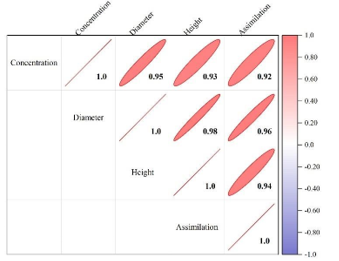Morpho-physiological response of Ochroma pyramidale produced in nurseries by biopot technology to N, P, K fertilisation using an optimal custom design
Main Article Content
Abstract
Ochroma pyramidale is a fast-growing species with high commercial value. The largest volumes of its wood are obtained from commercial plantations; however, there are very few studies of its production in nurseries. The objective of this study was analyse the effect of N, P, K concentration and fertilisation frequency on morpho-physiological response of O. pyramidale grown in biopots using response surface methodology. The experiment was set up using the response surface methodology for which 30 seedlings were used per experimental run. The experiment consisted of applying different concentrations of N, P, K and two fertilisation frequencies according to the optimal (Custom) design. The response variables were height increase, diameter increase and CO2 assimilation. From the results obtained, we confirmed the positive effect of N, P and K fertilisation on the variables under study. From the experimental data, a second-order quadratic polynomial model was found that allows the prediction of the morpho-physiological response of the species. The frequency of fertilisation during the time interval studied was not significant.
Downloads
Article Details

This work is licensed under a Creative Commons Attribution-NonCommercial 4.0 International License.
References
ANDIVIA, E., FERNÁNDEZ, M., AND VÁZQUEZ-PIQUÉ, J. 2011. Autumn fertilization of Quercus ilex ssp. ballota (Desf.) Samp. nursery seedlings: Effects on morpho-physiology and field performance. Ann. For. Sci. [en línea] vol. 68 no 3: 543-553. doi:10.1007/S13595-011-0048-4.
BORREGA, M., AHVENAINEN, P., SERIMAA, R., y GIBSON, L. 2015. Composition and structure of balsa (Ochroma pyramidale) wood. Wood Sci. Technol. [en línea] vol. 49 no.2: pp. 403-420. doi:10.1007/s00226-015-0700-5.
CAÑADAS-LÓPEZ, Á., RADE-LOOR, D., SIEGMUND-SCHULTZE, M., MOREIRA-MUÑOZ, G., VARGAS-HERNÁNDEZ, J.J., y WEHENKEL, C. 2019. Growth and yield models for balsa wood plantations in the coastal lowlands of Ecuador. Forests [en línea] vol. 10 no. 9. doi:10.3390/f10090733.
FERNÁNDEZ, M., NOVILLO, C., AND PARDOS, J.A. 2006. Effects of water and nutrient availability in Pinus pinaster Ait. open pollinated families at an early age: Growth, gas exchange and water relations. New For. [en línea] vol. 31 no. 3: pp. 321-342. doi:10.1007/s11056-005-8196-8.
FLETCHER, M.I. 1951. Balsa Production and utilization. Econ. Bot. [en línea] vol. 5, no. 2. pp. 107-125. doi:10.1007/BF02984770.
HAWKINS, B.J., BURGESS, D., y MITCHELL, A.K. 2005. Growth and nutrient dynamics of western hemlock with conventional or exponential greenhouse fertilization and planting in different fertility conditions. Can. J. For. Res. [en línea] vol. 35 no. 4: pp.1002-1016. doi:10.1139/x05-026.
LUIS, V.C., PUÉRTOLAS, J., CLIMENT, J., PETERS, J., GONZÁLEZ-RODRÍGUEZ, Á.M., MORALES, D., ANDy JIMÉNEZ, M.S. 2009. Nursery fertilization enhances survival and physiological status in Canary Island pine (Pinus canariensis) seedlings planted in a semiarid environment. Eur. J. For. Res. [en línea] vol. 28 no. 3: pp. 221-229. doi:10.1007/s10342-009-0257-7.
MADRID-AISPURO, R.E., PRIETO-RUÍZ, J.Á., ALDRETE, A., HERNÁNDEZ-DÍAZ, J.C., WEHENKEL, C., CHÁVEZ-SIMENTAL, J.A., AND MEXAL, J.G. 2020. Alternative substrates and fertilization doses in the production of Pinus cembroides Zucc. in nursery. Forests [en línea] vol. 11 no. 1. doi:10.3390/f11010071.
MAHMOUD, A.M.M., AND HUSSEIN, N.R. 2021. Influence of mineral fertilization and different growing media on the growth and chemical composition of Inga edulis Mart. tree seedling. svuijas.journals.ekb.eg [en línea] vol. 3 no. 3: pp. 16-29. doi:10.21608/SVUIJAS.2021.68858.1094.
MARENCO, R.A., DE, J.F., y VIEIRA, G. 2001. Photosynthesis and leaf nutrient contents in Ochroma pyramidale (Bombacaceae). Photosynthetica [en línea] vol. 39 no. 4: pp. 539-543. doi:10.1023/A:1015699927924.
MIYAJIMA, R., VITÓRIA CASTRO SANTOS BARRETO, PAULO ANDRÉ DE OLIVEIRA, GISLAINE CRISTINA BATISTELA, AND DANILO SIMÕES. 2018. Risk Analysis of the Economic Benefits of Ochroma pyramidale: A Case Study of Forest Planting in Brazil. J. Agric. Sci. Technol. B [en línea] vol. 8, no. 7. doi:10.17265/2161-6264/2018.07.004.
OLIET, J.A., PLANELLES, R., ARTERO, F., AND JACOBS, D.F. 2005. Nursery fertilization and tree shelters affect long-term field response of Acacia salicina Lindl. planted in Mediterranean semiarid conditions. For. Ecol. Manage. [en línea] vol. 215 no. 13. pp. 339-351. doi:10.1016/j.foreco.2005.05.024.
SHI, W., GROSSNICKLE, S.C., LI, G., SU, S., y LIU, Y. 2019. Fertilization and irrigation regimes influence on seedling attributes and field performance of Pinus tabuliformis Carr. Forestry [en línea] vol. 92 no. 1: pp. 97-107. doi:10.1093/forestry/cpy035.
TRUBAT, R., CORTINA, J., AND VILAGROSA, A. 2010. Nursery fertilization affects seedling traits but not field performance in Quercus suber L. J. Arid Environ. [en línea] vol. 74 no. 4: pp. 491-497. doi:10.1016/j.jaridenv.2009.10.007. VILLAR-SALVADOR, P., PUÉRTOLAS, J., y PEÑUELAS, J.L. 2009. Assessing Morphological and Physiological Plant Quality for Mediterranean Woodland Restoration Projects. L. Restor. to Combat Desertif. Innov. Approaches, Qual. Control Proj. Eval. [en línea] (Burdett 1990): pp. 103-120. Available from: http://www.research.lancs.ac.uk/portal/en/publications/assessing-morphological-and-physiological-plant-quality-for-mediterranean-woodland-restoration-projects(3769e750-2995-43ac-a859-dc65fc4b0041).html


